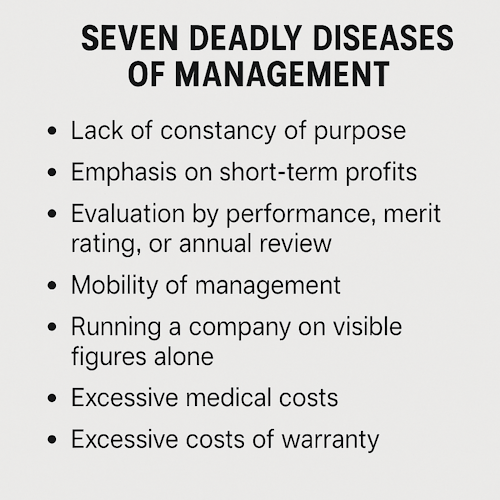Deming's 7 Deadly Diseases of Management
Identifies management habits that hinder long-term performance.
"The problem is at the top. Management is the problem."

W. Edwards Deming, one of the foundational thinkers behind modern quality management, identified seven systemic problems that undermine an organization's ability to continuously improve. Known as the Seven Deadly Diseases of Management,1 these were not merely bureaucratic flaws but deep-rooted dysfunctions in leadership thinking. For Agile organizations, which thrive on adaptability, collaboration, and learning, these diseases represent critical anti-patterns. They interfere with feedback loops, disempower teams, and obstruct systemic change, even when Agile frameworks are introduced. Deming's insight remains highly relevant today because it shifts attention from surface practices to the beliefs and structures that shape long-term performance.
Impact on Agile Organizations
The presence of one or more of Deming's diseases often signals that Agile adoption may stagnate or regress. These issues create organizational drag and breed cynicism, especially among teams trying to drive bottom-up improvements.
- Lack of Constancy of Purpose:
- Agile becomes a short-term experiment rather than a cultural shift.
- Strategy changes too frequently for teams to mature.
- Emphasis on Short-term Profits:
- Long-term investment in quality, technical excellence, or refactoring is neglected.
- Product decisions become reactive and marketing-driven rather than customer-centric.
- Evaluation by Performance, Merit Rating, or Annual Review:
- Undermines team cohesion by rewarding individual heroics.
- Obscures systemic causes of failure.
- Mobility of Management:
- Leaders lack contextual understanding of teams and systems.
- Frequent leadership churn disrupts trust and vision.
- Running a Company on Visible Figures Alone:
- Neglects qualitative insights from Retrospectives, customer interviews, and team sentiment.
- Metrics are gamed rather than used to improve learning.
- Excessive Medical Costs:
- While more specific to the US, rising healthcare costs can affect team morale, retention, and stability.
- Excessive Costs of Warranty:
- A proxy for poor quality practices, which Agile aims to correct through continuous delivery and automation.
- Signals systemic failure to build quality in.
Each of these can invalidate the gains Agile practices promise, by reasserting control structures, eroding trust, or discouraging experimentation.
Scenario
An enterprise adopts SAFe across multiple departments. While ceremonies and roles are in place, leadership still evaluates individuals with stack-ranking and bonus incentives. Managers are rotated every 18 months as part of a leadership development program. Strategic priorities shift quarterly based on executive KPIs, not customer feedback. Meanwhile, Agile coaches observe growing team apathy and declining psychological safety.
- Teams report stories to be "done" but rarely demo working software.
- Retrospectives yield the same unresolved issues each time.
- Developers hesitate to refactor, fearing it will hurt their delivery metrics.
These symptoms point to deeper management dysfunctions. Despite surface Agile compliance, the diseases Deming warned of persist and quietly erode the potential for lasting change.
Ways to Mitigate:
Mitigating these diseases requires deliberate shifts in leadership focus, policy, and culture. Agile coaches can help guide this transition through education, experiments, and systems thinking.
- Promote Long-term Purpose:
- Establish vision and principles that outlast quarterly cycles.
- Anchor OKRs to enduring goals rather than transient outputs.
- Rebalance Incentives:
- Shift away from individual evaluations to team-based outcomes.
- Incorporate qualitative data in feedback and recognition.
- Stabilize Leadership:
- Embed leaders with teams long enough to understand systemic constraints.
- Support leaders in learning Agile from the ground up.
- Embrace Invisible Insights:
- Use Retrospectives, user narratives, and observation in decision-making.
- Visualize flow, blockers, and communication paths.
- Invest in Quality:
- Make space for refactoring, automation, and exploratory testing.
- Track warranty-related costs as signals for improvement.
Conclusion:
Deming's Seven Deadly Diseases are not relics of mid-century management, they are still active risks in Agile transformations. Agile frameworks often prescribe ceremonies and structures, but unless leadership examines its own embedded habits, these diseases persist beneath the surface. Real change requires confronting these conditions and replacing them with systems that value learning, constancy, and intrinsic motivation. Coaches must recognize the signs, name them courageously, and work across levels to create healthier ecosystems.
Key Takeaways for Agile Teams
- Deming's diseases highlight root-level leadership dysfunctions that block Agile growth.
- Performance ratings and short-termism are especially corrosive to team trust and learning.
- Agile adoption without management transformation is fragile and likely to regress.
- Organizational health requires addressing invisible factors, not just metrics or roles.
- Quality, purpose, and stability must be reinforced from the top for Agile to thrive.
Summary
Deming's Seven Deadly Diseases of Management reveal how outdated leadership practices can sabotage Agile efforts from within. These systemic issues, such as short-term thinking, individual appraisals, and management churn, create conditions where Agile ceremonies may exist, but real agility cannot flourish. Agile coaches must help organizations see and treat these diseases, not as side concerns, but as central challenges to continuous improvement.